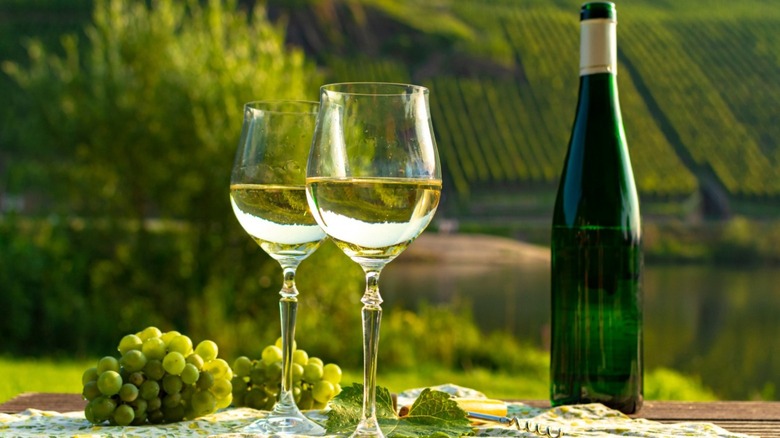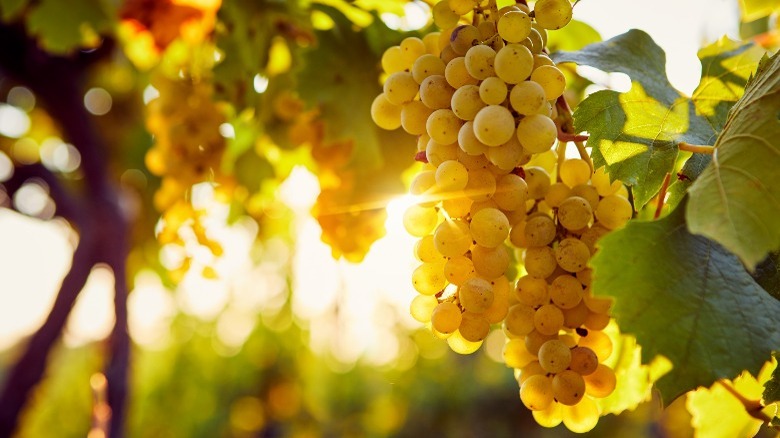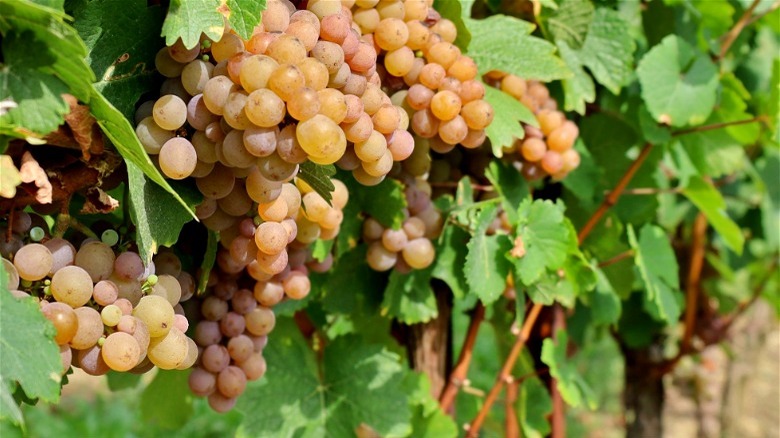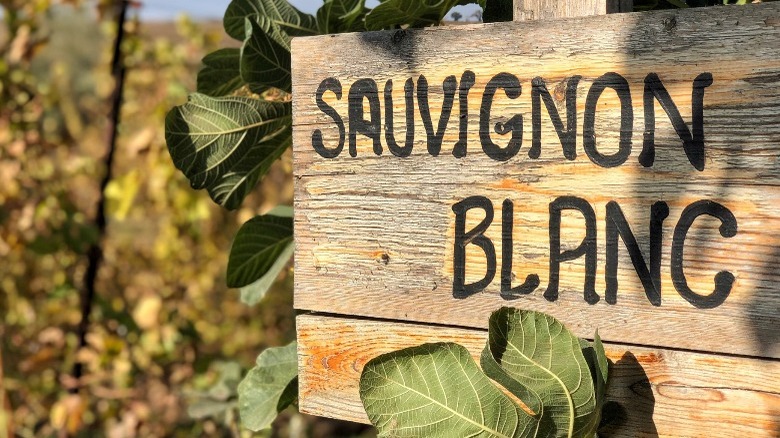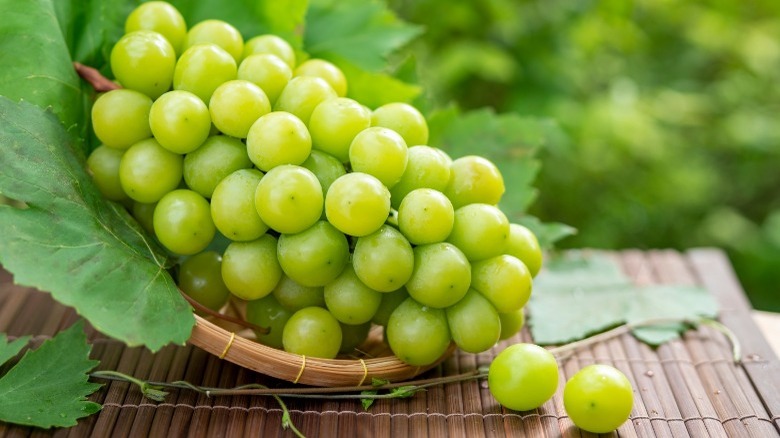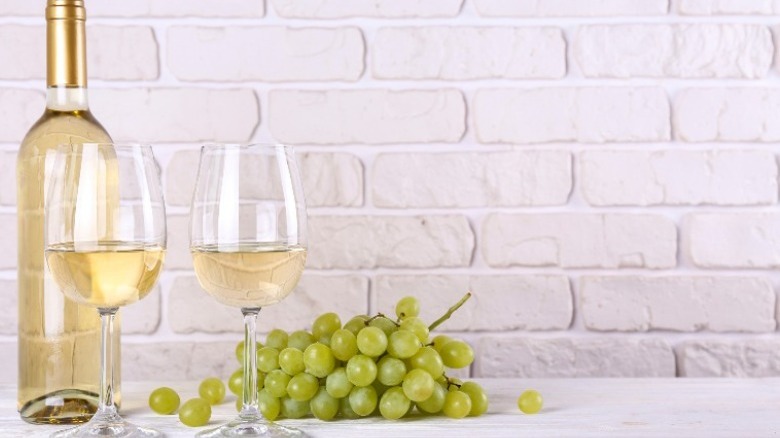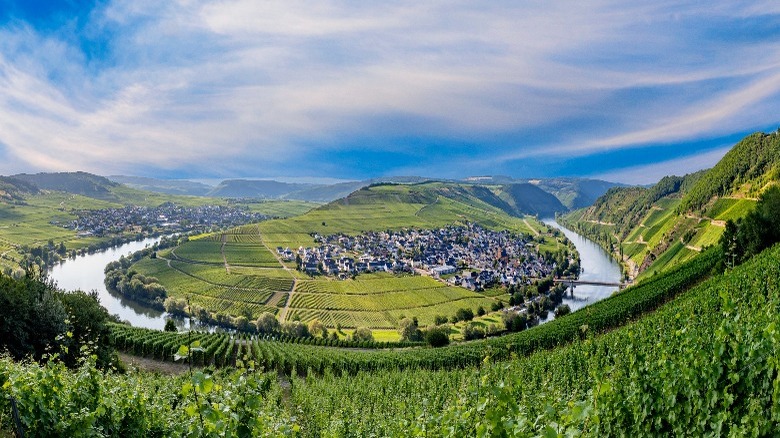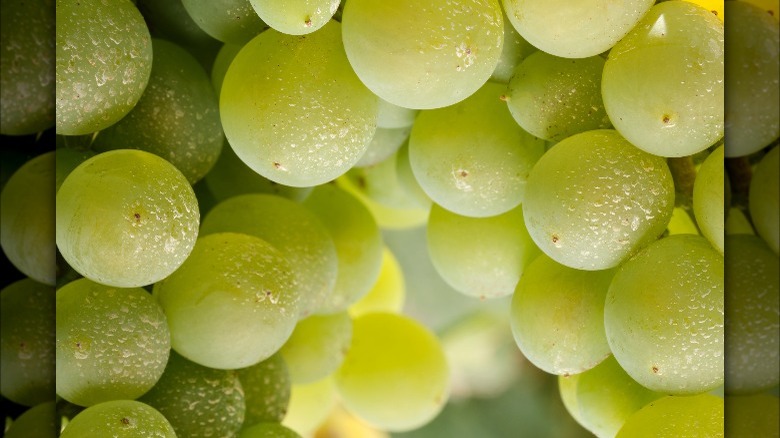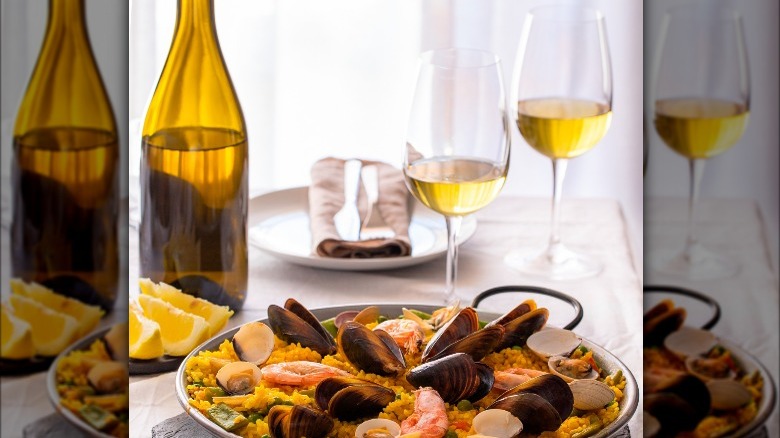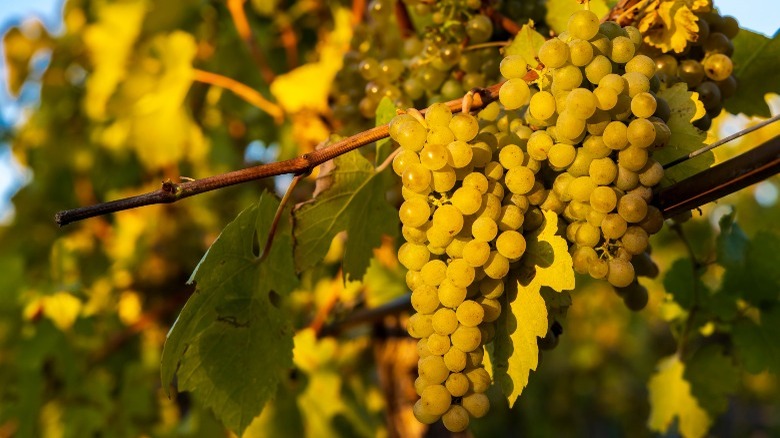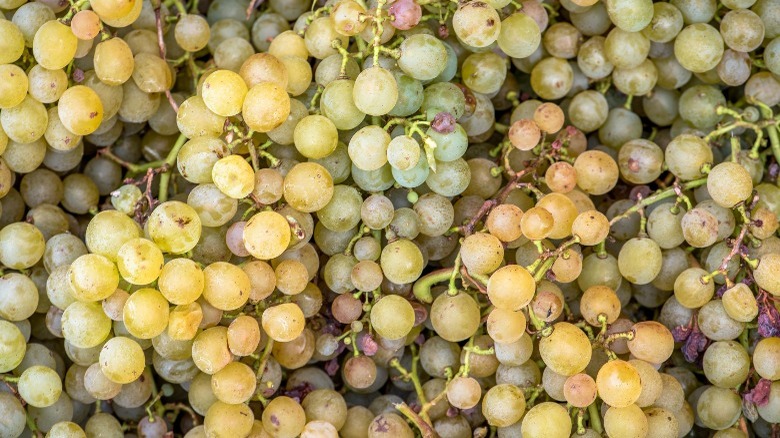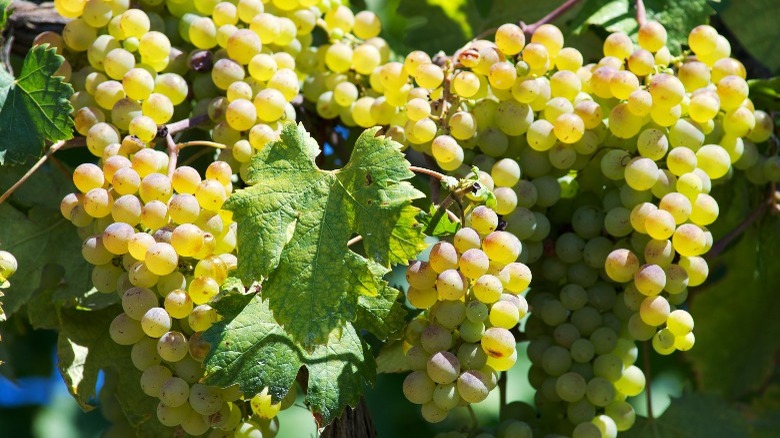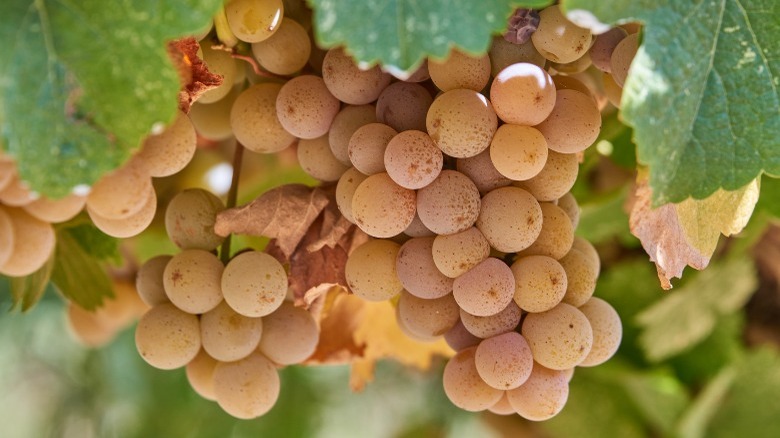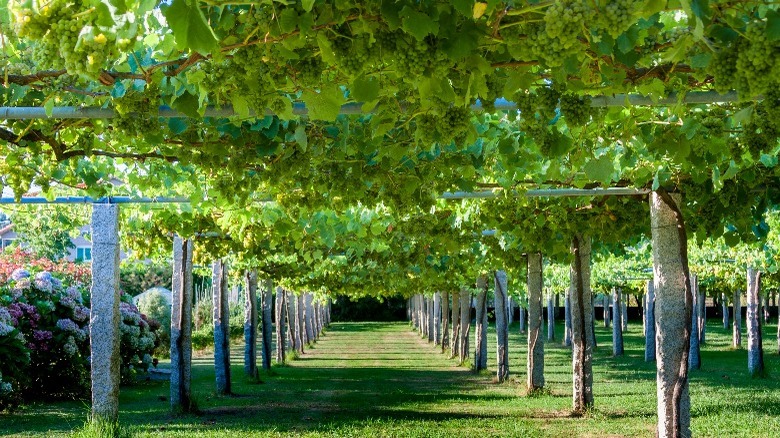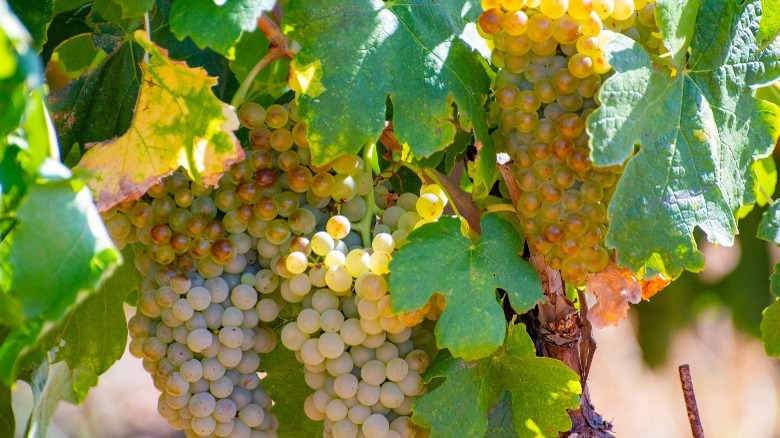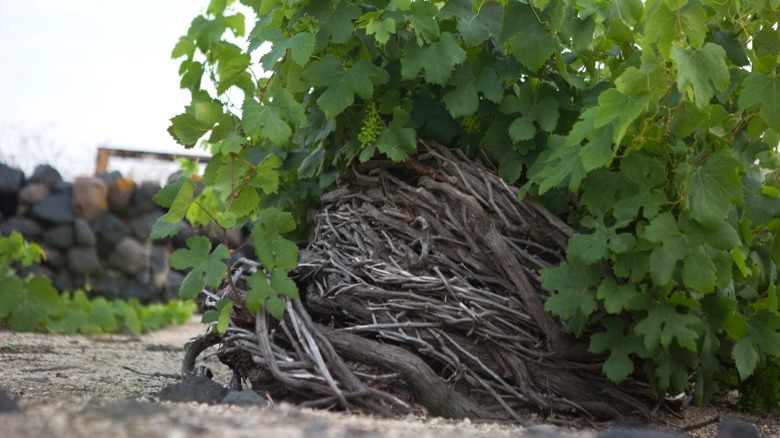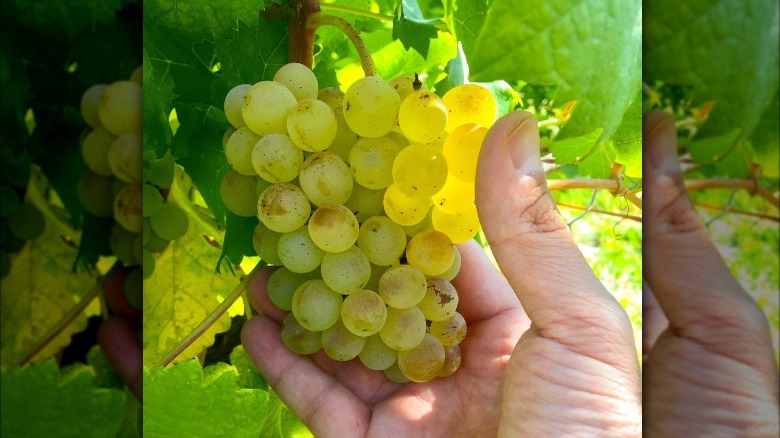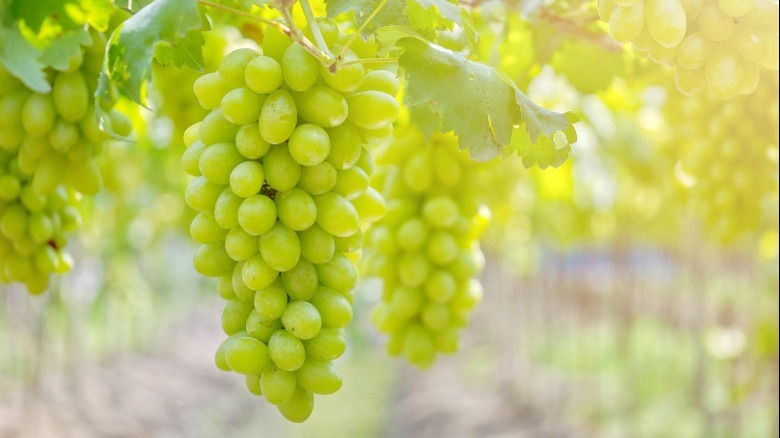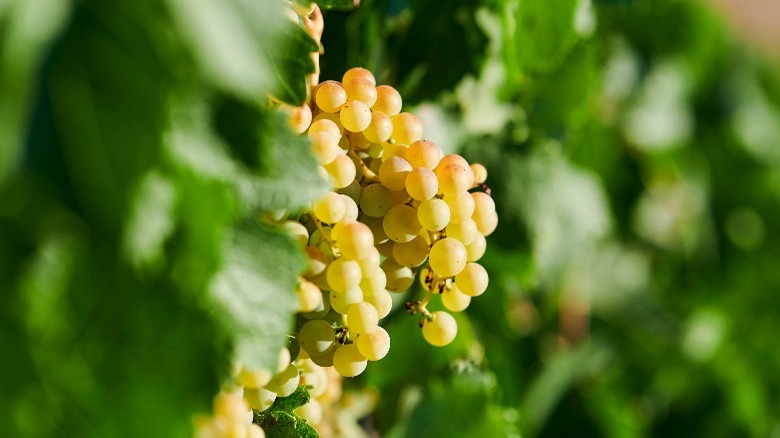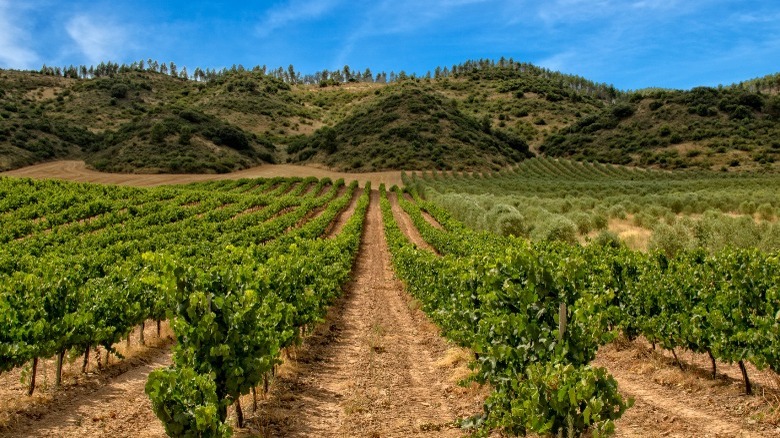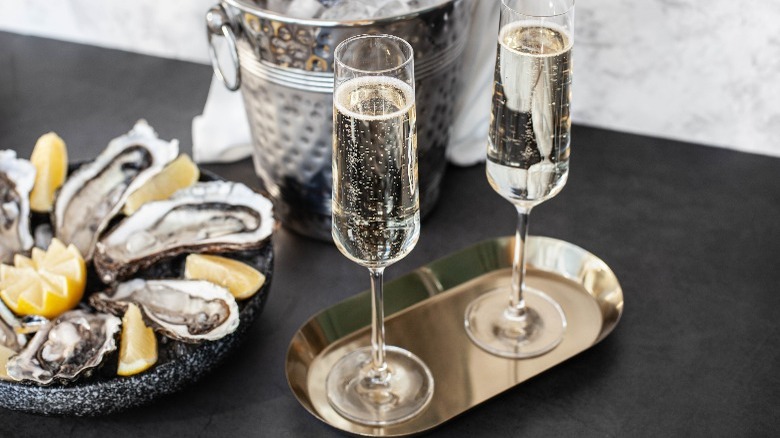Every Type Of White Wine Explained
When summer-like weather starts calling your name, it's time to pull out those lawn chairs, open up those sun umbrellas, and grab a cold glass of white wine. But white wine isn't just for casual imbibing. While many white wines are light and crisp enough to sip on their own, some are fuller and better served with food.
The beauty of white wine is that if you know what to look for, you can find a glass to fit any occasion. White wine is different from red wine because it's made from green grapes. This tends to give it a light texture, but the winemaker can always employ certain tactics to make it a more robust drink.
There are some distinct tasting notes and aromas to look out for to help you distinguish one white wine from the next. While you might not be able to guess the wine by looking at the bottle, with a little help, you'll know exactly what to pick up on your next trip to the wine shop.
Keep reading for a rundown on the most popular types of white wine.
Chardonnay
As Wine Enthusiast reports, chardonnay is the world's most popular white wine. These grapes can produce a bottle that appeals to lovers of any style of wine, making it a bit of a chameleon. Instead of looking for a specific taste profile, what you should expect from a chardonnay depends on where it was grown and the style in which it was vinified.
As both a cool- and warm-climate wine, chardonnay expresses itself beautifully either way. White Burgundy is perhaps the most well-known rendition of cool-climate chardonnay and will be crisp and refreshing, or richer, with deeper, more expressed notes, explains Food & Wine.
Chardonnay is a grape that's usually made in a varietal style, so it's often not blended with other types of wine. You can find chardonnay from all over the world, including France, California, Australia, Argentina, South Africa, and Switzerland (via Jancis Robinson). So what is it about chardonnay that makes wine lovers around the world go crazy? Chardonnay is a relatively straightforward wine to understand. It's low in acid and high in alcohol. And oftentimes, it features bold fruit notes. And if you're planning of a day of grilling, chardonnay just so happens to be a white wine that works perfectly with burgers. If you're not already a chardonnay fan, prepare to be.
Pinot grigio
You may have seen pinot grigio and pinot gris in the same section of the wine aisle at the grocery store. This is because they are indeed the same wine. Pinot grigio is the Italian name and pinot gris is the French name. This grape is often vinified into a simpler, lighter style that has notes of citrus rind. You might pick up some other notes like honeysuckle, but overall pinot grigio is usually not made in a style that's meant to shock the system. It is, however, made into a style that's pretty perfect for sitting in the park and nibbling on appetizers for hours on end. So while pinot grigio may not have a world-class reputation, it's always a good time when you open a bottle.
Pinot grigio is most commonly grown in Italy, France, and the United States — in fact, according to Gayot, Oregon pioneered the American version of the grape. If you've spent all afternoon making a white pizza, try it with a glass of crisp pinot grigio for the perfect pairing.
Sauvignon blanc
Sauvignon blanc originates from the Bordeaux region of France but has become popular all around the world (via Usual Wines). Its name derives from the French words "wild" and "white." You might be able to detect sauvignon blanc from other white wines by its mouth-puckering acidity and bright notes of grapefruit (via Wine Folly).
But for winemakers to keep the grape's acidity level high, sauvignon blanc needs to be grown in cool climates. That's why you'll commonly see sauvignon blanc grown in cooler regions of the world like western France and New Zealand.
Sauvignon blanc pairs well with herbaceous dishes like herb-crusted chicken, or with sweet-spicy cuisines like Vietnamese. Because sauvignon blanc has some vegetal notes, it's great when paired with fresh spring and summer vegetables like grilled asparagus. But of course, it's also perfect to sip on its own. And because it's often more fruity, as opposed to some heavier white wines, it's refreshing enough to drink all year long.
Muscat
This might be one of the most misunderstood grapes in the world. That's because in the United States, muscat is known as a sweet wine with big floral notes. The grape, muscat blanc, has varying names depending on the region. In Italy, the grape is called moscato, in Spain it's moscatel, and in Germany, muskateller.
in Italy, they vinify muscat as a slightly sparkling wine called moscato d'asti, which is a great option for brunches. A glass of ice cold moscato works well when served with some blueberry pancakes and syrup.
When made into a sweeter dessert-style wine without bubbles, which is typical in France, muscat is a beautifully floral wine that wows even the most skeptical drinker (via Wine Folly).
But no matter the style, muscat is easily recognized for its signature honeysuckle aromas. If you're new to wine and want to discover a way to pick up more smells, this is one that makes it easy to discern.
Pinot blanc
Pinot blanc is grown in large quantities in both Italy and France. Italian wines are called pinot bianco and the French version is pinot blanc. According to Food & Wine, they are made in noticeably different styles. The French wine is often richer, rounder, and creamier, while the Italian wine is a lot more fresh and bright. But good news — both versions work well with food so you can pick a bottle based on what you're in the mood for.
Pinot blanc isn't nearly as popular as some other grapes, but it might be time for that to change. These wines have nice aromas of apple and almond and are a nice blank canvas for the winemaker to add their signature touch. If you grab a bottle of pinot blanc, it'll be a guaranteed way to have a food-friendly white wine. Try it with vegetable pasta dishes, grilled chicken, or pad Thai.
This grape is also grown in Germany, where it's called weissburgunder, which translates to "white Burgundy" (via Wine Searcher). Fun fact: Pinot blanc is a relative of the popular red grape pinot noir.
Riesling
If you thought Riesling was mostly sweet, think again. That might have been the case historically, but nowadays, riesling is made in a wide range of styles. So if you're looking for a dry or sweet riesling, you'll have no trouble finding it. For sweet riesling, which make up some of the most expensive wines in the world, per Wealthy Gorilla, look out for auslese, or beerenauslese. And for drier styles, you should check the label for the word "trocken" which translates to "dry" in German.
Riesling is grown throughout Germany, with some notable versions originating from the steep slopes of the Mosel region. In addition to Germany, which is the home and champion of riesling, the grape is also grown in neighboring Austria, France, Southern Australia, and in the Finger Lakes region of the United States.
The quality of rieslings that are available is also rather vast. There are cheap, refreshing styles meant to be drunk immediately and some bottles of riesling that can be stored for decades. A younger style of riesling will have bold jasmine and green apple notes with a hint of beeswax, while older styles will have more subtle fruit aromas and a highly-desired petrol aroma (via Vine Pair). Riesling is almost always delicious with spicy Asian dishes and seafood.
Chenin blanc
Yet another chameleon of a grape, chenin blanc is likely to be your local sommelier's favorite grape. This grape can do it all: simple and chuggable, mineral-focused and precise, sweet, dry, you name it. In France, which boasts the title of chenin blanc's homeland, the Loire River flows from west to east. Along its journey, it touches some of France's most exciting wine appellations. Chenin blanc from this region can be either lighter or fuller-bodied, but will undoubtedly have aromas of apple, quince, and floral notes (via Wine Folly).
You might notice some similarities between chenin blanc and chardonnay. But it's especially noticeable in chenin blanc from South Africa, where the warmer temperatures help to create a fuller-bodied wine. It is sometimes blended with other white wines like sémillon and viognier to help give it richer notes. And when the wine is matured in oak, it's even more similar to Chardonnay. Because chenin blanc can be made in different styles, it pairs well with a lot of different dishes. But you can't go wrong with chenin blanc paired with herb-roasted chicken and vegetables.
Airén
Airén is all the rage in Spain, where it's the most widely planted grape of any color (via Guild Somm). The grape dates back to the 15th century when its subtle taste was thought to be better for raisins than wine. It's often used to make Spanish brandy, but when sold as a wine, it's usually blended with other wine varieties such as verdejo and viura.
And while airén doesn't have a reputation as the most notable wine, it is somewhat of a workhorse grape in the Spanish wine world. It works well in lighter styles of blends and because the grape has been growing in Spain for centuries, many of the growers are familiar with how to treat the vine to get the healthiest and best-tasting grapes.
Wine made from the airén grape has a medium-light body and has fairly low acidity. You may pick up some citrus notes like lemon and grapefruit, as well as some tropical fruit such as banana or pineapple.
Grüner veltliner
Grüner veltliner is the star grape of Austria, although it's also grown in other countries such as Hungary and Slovakia. This wine is known for its typical gooseberry, asparagus, and white pepper characteristics.
As much as it may play second fiddle to riesling with origins in the same parts of the world, these two wines have entirely different personalities. It's impossible to compare grüner veltliner to any other grape. Also, gruner veltliner is seldom aged in oak, so it often doesn't take on a richer, fuller-bodied style like chardonnay.
It's notable for its high acidity, which brings a nice zing to the palate when accompanied by food. It's a favorite among sommeliers for its food-friendly characteristics, so you might see it on the menu the next time you're at dinner (via Jancis Robinson). Try Grüner Veltliner with sashimi to see just how wonderful of a wine it is!
Sémillon
As a notable blending grape, sémillion doesn't often get to shine on its own. It adds body and a weighty, oily texture to blends that can't be delivered from any other grape. Sémillon originates from Southwest France which regularly sees hot temperatures. The Tramontane wind current gives the region some respite from sweltering temperatures, but overall it's too hot for the grape to reach any notable levels of acidity to stand on its own.
Even in Sauternes, a region with its namesake style of fine sweet wine from Bordeaux, it's blended with other wines such as sauvignon blanc and muscadelle (via The Grape Grind). Sauternes relies on those signature Sémillon notes of peach, lemon, and honey as well as its texture. These wines must undergo noble rot through the botrytis fungus. This desirable fungus punctuates the grape skins, allowing all of the liquid to evaporate, leaving only concentrated sweet juice.
Sémillon is also grown in South Africa, and in less notable quantities in the USA, Argentina, and Chile.
Vermentino
Vermentino, which Wine Folly says is comparable to sauvignon blanc, is a bright and light-bodied wine from Italy. If you open a bottle of vermentino, prepare to be transported to the Italian riviera. That's because this grape is typically grown in the Western Italian coastal region of Liguria and the sun-drenched island of Sardinia.
It's an exciting wine to taste because at first glance it's a simple, dry white wine, but it evolves on the palate. It starts with notes of pear and grapefruit and often finishes with a beautiful salinity. You might also pick up some hints of oiliness on the palate. Vermentino is most often made in a lighter style, but some versions offer a bit more richness. You can keep it pretty simple with vermentino. Grab some good bread, spread with green pesto, and enjoy! Wines made from this grape are meant for being enjoyed with good food and even better friends.
Gewürtztraminer
If you don't speak German, the word gewürztraminer may look complicated, but just like the wine, its mystique gives way to approachability. 'Gewürz' is the German word for 'spice' and 'traminer' is a white grape that originates in the Western Austrian region of Tyrol. The 'spice' may refer to gerwürztraminer's signature ginger or clove-like notes.
Gewürztraminer is a bit of a head-scratcher, though, because for a wine that is not particularly high in acid, it can be vinified into remarkably interesting styles, and it has been enticing palates since 1145 (via Wine Dharma). In northern Italy, the grape took to the clay ground and altitude of the town Tramin. It would later travel to Germany and Austria and find its home in both places, as gewürztraminer really just adores cooler climates.
In addition to the distinct spice notes in gewürztraminer, these wines also have telltale lychee aromas that make it easy to detect in a tasting. Halleck Vineyard suggests pairing gewürztraminer with duck, fish and Moroccan tagines!
Albariño
The northwestern Spanish wine region of Rias Baixas is known for elegant and cheerful white wines. Albariño is perhaps the most important of them all. This coastal area receives a lot of cooling breezes from the Atlantic Ocean, which allows the grapes to retain a dazzling acidity, while still developing sugar. Albariños from Rias Baixas are known for stone fruit aromas like peach and apricot, along with grapefruit and melon notes, explains Wine Pros.
There is a high amount of moisture in the area, though, so to avoid mildew on the grapes, they are raised about six feet off the ground on an aerial trellis called a parra. This allows the grapes to get adequate airflow and stay dry, and makes for a unique canopy when walking undeneath.
Albariño is also grown in Portugal, where it is a key component in vinho verde wines. Here it's called alvarinho and it displays notes of honeydew and grapefruit. When in doubt, pair these wines with local dishes. In the case of albariño, that would be seafood like oysters, mussels, scallops, and crab legs.
Roussanne
Roussanne might win the title for most mysterious white wine. It is complicated to grow, yet has managed to garner attention in its homeland of the Northern Rhône in France. It's not a wine that you may have seen on a bottle because it's normally vinified as a blend along with its buddy marsanne. But it's definitey a wine worth trying.
This wine is beloved in France for its elegance and aromatic qualities. Into Vino suggests you look out for notes of apricot, honeysuckle, and some citrus. While this isn't a massively acidic wine, it often has balanced amounts to ensure the wine is still refreshing. You may also spot American-made roussanne, which is vinified in a richer style, similar to the much-beloved chardonnay grape. If you've managed to nab a bottle of roussanne, drink it with spicy Asian dishes or meats in cream sauces for a mouth-watering experience.
Assyrtiko
Despite the fact that it's such a small region, the Assyrtiko grape varietal that originates from Greece's Santorini Island has managed to cross the globe, gaining respect along the way. Assyrtiko is a grape that can thrive in Greece's hot, dry conditions and that produces interesting white wine. Combine that with assyrtiko's fuller body and minerality and you've got a wine that is made for drinking on lazy summer evenings with a heaping portion of fresh shellfish.
In addition to mouth-watering acid, assyrtiko typically has notes of lime and passionfruit (via Wine Folly). Today, it's heralded as one of Greece's most important grapes. While assyrtiko is often made in dry styles, Wines of Greece also reports that you may stumble across a sweet assyrtiko if you're lucky. It is an intense wine, but a pleasurable one. And it checks all the boxes for those looking for an interesting, refreshing, and food-friendly option.
Cortese
If France is the reigning champion of winemaking and viticulture, Italy comes in a close second place. Grape varieties such as cortese are a solid reminder of that. This white grape dates back to early 17th-century Italy (via Vine Pair). And while it isn't as notable as some other Italian varieties, it delivers solidly refreshing white wine with notes of apple, almond, and citrus.
Cortese is the primary grape of the Gavi appellation, so you may have spotted Gavi or Gavi di Gavi on some bottles. Cortese is often made into a light, easy-drinking dry style of wine. It pairs wonderfully with any dish from coastal regions of Italy. You can't go wrong with light seafood dishes sprinkled with basil alongside a chilled glass of Gavi. It may be an Italian underdog, but it's a solid choice when you want to have a Mediterranean-inspired meal with perfectly paired wine.
Grenache blanc
As its name may suggest, grenache blanc is indeed a relative of the red grape grenache. Grenache blanc is called garnacha blanc in Spanish. It is well-loved for good reason. Wines made from grenache blanc are complex and rich, full of aromas of nuts, stonefruit, and flowers. It's not a terribly common grape, but if you're looking for a wine that's more unique, you can't go wrong with a bottle of grenache blanc.
The fun of grenache blanc, besides its delicious taste, is that it does well in most situations. It's beautiful as a varietal wine, but it's also a stellar wine to blend, which is how it's often handled in Southern France when it's blended with roussanne and marsanne, explains Wine Traveler. It's also made into sweet wines in France's Rivesaltes area, and it can undergo certain processes to adjust its texture to have a more round feel. There are even grenache blanc vines in California. Grenache blanc is truly a jack of all trades.
Verdejo
Nestled in central Spain sits a wine region that has generously shared its native grape with the world. Verdejo is a grape that has been grown with care in the Rueda region of Spain, likely for centuries. But it wasn't until the 1980s that Verdejo rose in popularity to become the flagship grape variety of Rueda.
Verdejo thrives in Rueda, with its long, hot summers and cold winters. Vine Pair reports the region has rocky limestone soil, which provides nutrients for the vines to happily flourish throughout the season. When tasting Verdejo, Decanter suggests looking out for herbaceous fennel and grass notes, along with some citrus and stone fruit. Sometimes you might find it blended with viura, but if you see Rueda verdejo on the label, it is indeed at least 85% verdejo.
These wines won't be the heady type to stun you into silence, but they're easy-drinking, food-friendly, and perfect for those times when you need to track down a fun bottle on a budget.
Viura
Rioja may be one of the most well-known types of wine in the world. As a red wine, it's often age-worthy, elegant, and bursting with aromas of tobacco, plums, and berries. So perhaps it's time for white Rioja wines to receive just as much attention.
Viura or macabeo, as it's called in France, is the primary grape used in the white style of Rioja wines, or Rioja blancos. As with the red Riojas, Rioja blancos adhere to specific aging regulations to be able to include certain words on the bottle's label.
Reserva Rioja blanco, for example, must be aged for 24 months, with 6 months in an oak cask, says Wine Folly. While it may seem complicated, the most important thing to note is that you can expect some different tastes depending on the age of the wine. Older Rioja blancos will have nutty, caramelized notes, while younger ones will have more citrus notes.
So what to eat with your viura or Rioja blanco? Keep it easy with foods that are traditionally served in Spain: cheese, grilled meats, and fish won't let you down (via Recette Magazine).
Sparkling wine
Bubbles are an instant party starter! Just pop the cork and let the party begin. Sparkling wine is a vast category that can also include red wines. But the good majority (and perhaps the most prominent examples) of sparkling wines, are white wines. The style of sparkling refers to any wine that contains carbon dioxide, which gives wine its bubbles. In Champagne, prosecco, sekt, and Cava, for example, the carbonation occurs naturally after the wine has fermented. Some cheaper wines are artificially carbonated, though.
There are different sets of standards for sparkling wine depending upon where it comes from, but there is a sparkling wine to fit each price point. Champagne, which includes sparkling wines from the Champagne region of France, are always great for a splurge, but you can find delicious bubbles from Germany and Spain, too.
Sparkling wine is perfect to pair with food because it's often more neutral in taste, so it complements, rather than outshines, most food. If you're looking for the perfect wine to sip with a spread of fried chicken, pasta salad, oysters, and roasted veggies, grab some sparkling wine for an easy pairing.
